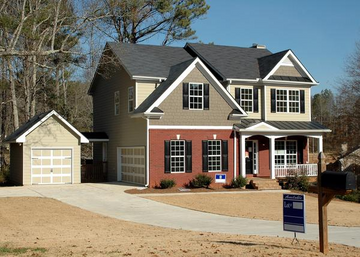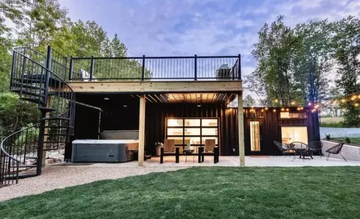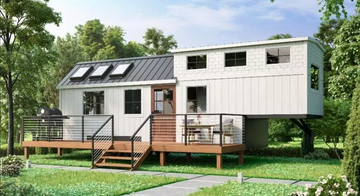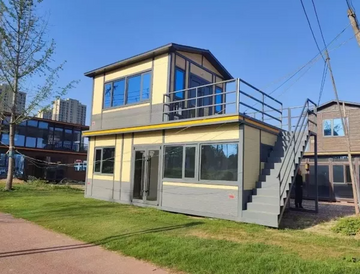The price of a manufactured home varies based on a variety of factors, including size, design, materials, location, and extra features. Generally, manufactured homes range in price from $50,000 to $300,000 or more. Basic manufactured homes feature standard designs with less customization and lower prices. Custom manufactured homes that are larger, have more complex designs, and feature high-end materials and features are more expensive.
Something to consider is that the price of a manufactured home typically includes not only the structure itself, but also delivery, assembly, and any additional customization or features. In addition, the cost of land, foundation, utilities and permits should also be considered. Below I will cover the cost of a prefabricated integrated house from many aspects to give a complete understanding of the total cost of a prefabricated house.
design fees
The cost of designing a manufactured home depends on several factors, including the size, complexity, level of customization and professional design services required. Generally speaking, the design fee of a prefabricated house may account for 5% to 15% of the total cost.
The basic manufactured home design is usually provided by the manufacturer and included in the total cost of the home. This standard design is usually the lower cost option. And if you require a custom design, you may need to pay an additional designer fee. Custom design fees depend on the designer's qualifications, experience and the amount of work required.
When considering the cost of a prefabricated house design, there are other costs associated with the design that need to be taken into account, such as planning permission, engineering consultancy and project management fees. These costs may vary by region, project size and design complexity.
Overall, the cost of a manufactured home design is a question that needs to be evaluated on a case-by-case basis, and it is recommended that you consult a professional to obtain a detailed cost estimate before proceeding with the design.
Different sizes cost different
The size of a manufactured home has a direct impact on its cost. Generally speaking, the price of a manufactured home increases with size. Here are some factors that influence the cost of manufactured home size:
1. Cost of building materials: Larger-sized houses require more building materials, including walls, roofs, floors, etc., which will directly affect the cost.
2. Transportation costs: Larger-sized prefabricated homes may require more transportation space, resulting in increased transportation costs.
3. Foundation and Foundation Costs: Larger manufactured homes may require more complex foundation and foundation work, which also increases costs.
4. Level of customization: Large, custom-made prefabricated homes often increase design and engineering complexity, and therefore cost.
Overall, the size of a manufactured home has a direct impact on the cost, so when considering the size of a manufactured home, you need to consider the above factors as well as other possible cost factors.
Material costs
The cost of materials for a manufactured home depends on several factors, including the size of the home, its design, quality of materials and price levels in the area. Generally speaking, the materials of prefabricated houses include the following aspects:
1. Structural materials: Structural materials including walls, roofs, floors, etc., usually wood, concrete, steel or composite materials. The price of these materials depends on their quality and usage.
2. Exterior decoration materials: such as exterior wall materials, windows, doors, etc. The selection of these materials will affect the appearance and thermal insulation performance of the house.
3. Interior decoration materials: including floors, siding, ceilings, kitchen and bathroom equipment, etc. The quality and style of these materials will also affect the cost.
4. Insulation materials: Insulation materials used for insulation and insulation are critical to the comfort and energy efficiency performance of prefabricated homes.
5. Other materials: such as pipes, electrical wiring, ventilation equipment, etc. These materials are also an integral part of the construction process of prefabricated houses.
It's important to note that different manufactured home manufacturers and designers may use different materials and suppliers, so material costs will vary. At the same time, when considering the material costs of a manufactured home, indirect costs such as transportation, installation and construction also need to be taken into account.
Cost of site selection
The cost of site selection for a manufactured home is somewhat similar to the cost of site selection for traditional construction, but there are some special considerations. Here are some factors that influence the cost of siting a manufactured home:
1. Land cost: The first is the cost of purchasing land, which depends on the location, size of the land and the supply and demand of the land market.
2. Land preparation work: including clearing, grading, road construction, water and electricity pipeline connection and other projects, which will have an impact on the cost.
3. Land plans and permits: Land plans and permit application fees need to be considered to ensure compliance with local building codes and regulations.
4. Infrastructure: Local infrastructure needs to be considered, including water supply, power supply, drainage, etc., as well as the cost of accessing these infrastructures.
5. Land environmental assessment: Sometimes it is necessary to conduct environmental assessment work such as soil testing and geological exploration to ensure the feasibility and safety of the site selection.
6. Transportation costs: If the site is remote, the cost of transporting the prefabricated house to the site needs to be considered.
7. Taxes and insurance: Land purchase tax, property tax and possible insurance fees need to be considered.
Labor cost
Labor costs for manufactured homes can be somewhat different relative to traditional construction. The manufacturing and construction process for prefabricated homes is generally more industrial and standardized, so labor costs may be reduced in some respects. Here are some factors that affect manufactured home labor costs:
1. Labor costs in manufacturing plants: Prefabricated housing is usually produced in factories, so labor costs may be affected by local factory worker wage levels.
2. Labor costs in the assembly and construction stages: When transporting prefabricated components to the site for assembly and installation, the wages of on-site workers and related labor costs need to be considered.
3. Skilled workers and supervisors: Skilled workers and supervisors are needed during the manufacturing and construction process of prefabricated houses to ensure quality and safety, and their salary levels will also affect the overall cost.
4. Assembly lines and automated equipment: Some prefabricated house manufacturers use assembly lines and automated equipment to improve production efficiency, which may reduce some labor costs.
The above is the analysis of several cost factors for building integrated houses. In general, prefabricated houses save 15% of the housing cost than traditional houses, and the price/performance ratio is very high. I hope this article can help you in terms of cost. You have a perfectly integrated home.





